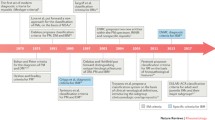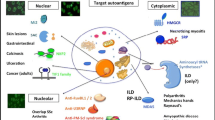Abstract
Patients with idiopathic inflammatory myopathies (IIMs), referred to as myositis, are prone to infectious complications, which hinder the treatment of the disease and worsen the outcome of patients. The purpose of this study was to explore the different types of infectious complications in patients with myositis and to determine the predisposing factors for clinical reference. A retrospective study was conducted on 66 patients with IIM who were divided into different subpopulations by an unsupervised analysis of their clinical manifestations, laboratory features, and autoantibody characteristics. Combined with the incidence of infectious complications, the types of infectious pathogens and the sites of infection, the characteristics of infection, and susceptibility factors were explored. Three clusters with significantly different clinical characteristics and coinfection rates were identified (76.2% vs. 41.6% vs. 36.4%, p = 0.0139). Cluster 1 (n = 12) had a moderate risk of infection, with an infection rate of 41.6%. The patients in cluster 1 had a high probability of positive mechanic’s hands, periungual erythema, anti-Ro52 antibody, and anti-Jo1 antibody. CD3 and CD4 were the highest among the three groups. Cluster 2 (n = 21) had a high risk of infection, and the incidence of infection was 76.2%. Almost all patients in this cluster had a rash, prominent clinical symptoms, and decreased WBC, PMN, LYM, CD3, and CD4 counts. Cluster 3 (n = 33) had a low risk of infection, with an infection rate of 36.4%. Compared with the other two clusters, cluster 3 (n = 33) lacked a typical rash but had a high ANA-positive rate. The patients in cluster 1 and cluster 3 were mainly infected by viruses, followed by bacterial infections. In cluster 2 patients, bacterial infections were the most prevalent. Fungal and Pneumocystis carinii were common causes of cluster 2 and 3 infections. In addition, the patients within a cluster often have a single infection, and pulmonary infections are the most common. We clustered the patients with IIM complicated with infection into three different types by their clinical symptoms and found that there were differences in the infection risk and infection types among the different cluster groups.




Similar content being viewed by others
Data Availability
The data supporting the conclusions of this article are included within the article and its additional file.
References
Baig, S., and J.J. Paik. 2020. Inflammatory muscle disease — an update. Best Practice & Research: Clinical Rheumatology 34(1):101484. https://doi.org/10.1016/j.berh.2019.101484
Schmidt, J. 2018. Current classification and management of inflammatory myopathies. Journal of Neuromuscular Diseases 5 (2): 109–129. https://doi.org/10.3233/JND-180308.
Dalakas, M.C. 2015. Inflammatory muscle diseases. New England Journal of Medicine 372 (18): 1734–1747. https://doi.org/10.1056/NEJMra1402225.
Carstens, P.O., and J. Schmidt. 2014. Diagnosis, pathogenesis and treatment of myositis: Recent advances. Clinical and Experimental Immunology 175 (3): 349–358. https://doi.org/10.1111/cei.12194.
Marie, I., E. Hachulla, P. Chérin, M.F. Hellot, S. Herson, H. Levesque, and P.Y. Hatron. 2005. Opportunistic infections in polymyositis and dermatomyositis. Arthritis and Rheumatism 53 (2): 155–165. https://doi.org/10.1002/art.21083.
Redondo-Benito, A., A. Curran, A. Villar-Gomez, E. Trallero-Araguas, A. Fernández-Codina, I. Pinal-Fernandez, J.Á. Rodrigo-Pendás, and A. Selva-O’Callaghan. 2018. Opportunistic infections in patients with idiopathic inflammatory myopathies. International Journal of Rheumatic Diseases 21 (2): 487–496. https://doi.org/10.1111/1756-185X.13255.
Juárez, M., R. Misischia, and G.S. Alarcón. 2003. Infections in systemic connective tissue diseases: Systemic lupus erythematosus, scleroderma, and polymyositis/dermatomyositis. Rheumatic Diseases Clinics of North America 29 (1): 163–184. https://doi.org/10.1016/s0889-857x(02)00100-x.
Bohan, A., and J.B. Peter. 1975. Polymyositis and dermatomyositis (first of two parts) (J). New England Journal of Medicine 292 (7): 344–347.
Furst, D.E., A.A. Amato, Ş.R. Iorga, K. Gajria, and A.W. Fernandes. 2012. Epidemiology of adult idiopathic inflammatory myopathies in a U.S. managed care plan. Muscle Nerve 45 (5): 676–83. https://doi.org/10.1002/mus.23302
Strauss, T., and M.J. von Maltitz. 2017 Generalising Ward’s method for use with Manhattan distances. PLoS One 12 (1): e0168288. https://doi.org/10.1371/journal.pone.0168288
Coombes, C.E., X. Liu, Z.B. Abrams, K.R. Coombes, and G. Brock. 2021. Simulation-derived best practices for clustering clinical data. Journal of Biomedical Informatics 118: 103788. https://doi.org/10.1016/j.jbi.2021.103788
Falagas, M.E., K.G. Manta, G.I. Betsi, and G. Pappas. 2007. Infection-related morbidity and mortality in patients with connective tissue diseases: A systematic review. Clinical Rheumatology 26 (5): 663–670. https://doi.org/10.1007/s10067-006-0441-9.
Miró, O., M. Laguno, J.R. Alonso, J. Casademont, C. Herrero, A. Selva, A. Urbano-Márquez, and J.M. Grau. 1999. Evolución de las miopatías inflamatorias idiopáticas: complicaciones, supervivencia y factores pronósticos Clinical course of idiopathic inflammatory myopathies: complications, survival and prognostic factors. Medicina Clínica 112 (14): 521–6. Spanish. PMID: 10363237
Connolly, A., P.A. Gordon, J. Hannah, and D. Creamer. 2021. The chameleon rash: A review of the polyphenotypic dermatoses of dermatomyositis. Clinical and Experimental Dermatology 46 (6): 1016–1022. https://doi.org/10.1111/ced.14689.
Ge, Y.P., X.M. Shu, L.R. He, G.C. Wang, and X. Lu. 2022. Infection is not rare in patients with idiopathic inflammatory myopathies. Clinical and Experimental Rheumatology 40 (2): 254–259. https://doi.org/10.55563/clinexprheumatol/yps7ai.
Chen, I.J., W.P. Tsai, Y.J. Wu, S.F. Luo, H.H. Ho, L.B. Liou, J.Y. Chen, C.F. Kuo, H.C. Chang, C.H. Yang, and K.H. Yu. 2010. Infections in polymyositis and dermatomyositis: Analysis of 192 cases. Rheumatology (Oxford) 49 (12): 2429–2437. https://doi.org/10.1093/rheumatology/keq279.
Wik, J.A., and B.S. Skålhegg. 2022. T cell metabolism in infection. Frontiers in Immunology 13: 840610. https://doi.org/10.3389/fimmu.2022.840610
Medzhitov, R. 2007. Recognition of microorganisms and activation of the immune response. Nature 449 (7164): 819–826. https://doi.org/10.1038/nature06246.
Feng, M., H. Guo, C. Zhang, C. Wang, Z. Liang, X. Zhao, Y. Qin, Y. Wu, G. Liu, C. Gao, and J. Luo. 2019. Absolute reduction of regulatory T cells and regulatory effect of short-term and low-dose IL-2 in polymyositis or dermatomyositis. International Immunopharmacology 77: 105912. https://doi.org/10.1016/j.intimp.2019.105912
Arning, M., and C. Aul. 1994. Mykose-Prophylaxe bei neutrozytopenischen Patienten [Prophylaxis against mycoses in neutropenic patients]. Mycoses 37 Suppl 2: 70–6. German
Xiao, Y., X. Zuo, Y. You, H. Luo, L. Duan, W. Zhang, Y. Li, Y. Xie, Y. Zhou, W. Ning, T. Li, S. Liu, H. Zhu, Y. Jiang, S. Wu, and H. Zhao. 2016. Investigation into the cause of mortality in 49 cases of idiopathic inflammatory myopathy: A single center study. Experimental and Therapeutic Medicine 11 (3): 885–889. https://doi.org/10.3892/etm.2016.3006.
Chatterjee, R., P. Mehta, V. Agarwal, and L. Gupta. 2021. High burden of infections in Indian patients with Idiopathic Inflammatory Myopathy: Validation of observations from the MyoCite dataset. Rheumatology (Oxford) 60 (9): 4315–4326. https://doi.org/10.1093/rheumatology/keab015.
Marie, I., E. Hachulla, and P. Che´rin, et al. 2005. Opportunistic infections in polymyositis and dermatomyositis. Arthritis Rheumatoid 53: 155–65, Infections in polymyositis and dermatomyositis: analysis of 192 cases
Huang, L., W. Zhu, Y. Ye, X. Wu, Q. Yan, Z. Wang, Y. Lin, and S. Chen. 2021. Association of cytomegalovirus infection with anti-MDA5 antibody-positive dermatomyositis: a prospective cohort study. Frontiers in Medicine (Lausanne) 8: 740154. https://doi.org/10.3389/fmed.2021.740154
Mecoli, C.A., and S.K. Danoff. 2020. Pneumocystis jirovecii pneumonia and other infections in idiopathic inflammatory myositis. Current Rheumatology Reports 22 (2): 7. https://doi.org/10.1007/s11926-020-0883-0.
Haldule, S., M. Chatterjee, R.P. Goswami, I. Vadsaria, P. Gaur, C. Kavadichanda, D.P. Misra, H. Chinoy, V. Agarwal, R. Aggarwal, and L. Gupta. 2022. A systematic review and meta-analysis of mycobacterial infections in patients with idiopathic inflammatory myopathies. Rheumatology (Oxford) 61 (9): 3521–3533. https://doi.org/10.1093/rheumatology/keac041.
Funding
This work was supported by the National Natural Science Foundation of China (82001728, 81973540); 1·3·5 project for Outstanding interdisciplinary project of West China Hospital, Sichuan University (ZYGD18015, ZYJC18003, ZYJC18024); Sichuan Science and Technology Program (20YYJC3358); and from zero to one Innovative Research Program of Sichuan University (2022SCUH0020).
Author information
Authors and Affiliations
Contributions
L. Y., T. C. Y., and L. Y. B. conceived and designed the study. L. Y. and T. C. Y. guided the study. C. L., L. Y. H., W. Y. L., Z. Y., L. Z. H., W. J., L. X. P., and W. T. collected the clinical samples. C. L., L. Y. H., and W. Y. L. analyzed the data. All authors drafted and revised the manuscript. All authors drafted and revised the manuscript. Lu Cheng and Yanhong Li contributed equally to this work.
Corresponding authors
Ethics declarations
Ethics Approval and Consent to Participate
The study was approved by the ethical committee of West China Hospital of Sichuan University (No. 695 in 2020) and complied with the Declaration of Helsinki. The study did not involve animal studies, and no ethical approval was needed.
Consent for Publication
All patients and controls provided written informed consent.
Competing Interests
The authors declare no competing interests.
Additional information
Publisher's Note
Springer Nature remains neutral with regard to jurisdictional claims in published maps and institutional affiliations.
Rights and permissions
Springer Nature or its licensor (e.g. a society or other partner) holds exclusive rights to this article under a publishing agreement with the author(s) or other rightsholder(s); author self-archiving of the accepted manuscript version of this article is solely governed by the terms of such publishing agreement and applicable law.
About this article
Cite this article
Cheng, L., Li, Y., Wu, Y. et al. Risk of Early Infection in Idiopathic Inflammatory Myopathies: Cluster Analysis Based on Clinical Features and Biomarkers. Inflammation 46, 1036–1046 (2023). https://doi.org/10.1007/s10753-023-01790-w
Received:
Revised:
Accepted:
Published:
Issue Date:
DOI: https://doi.org/10.1007/s10753-023-01790-w




